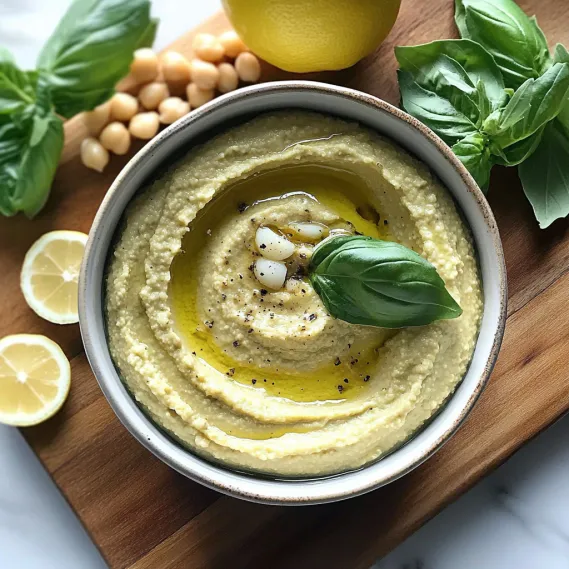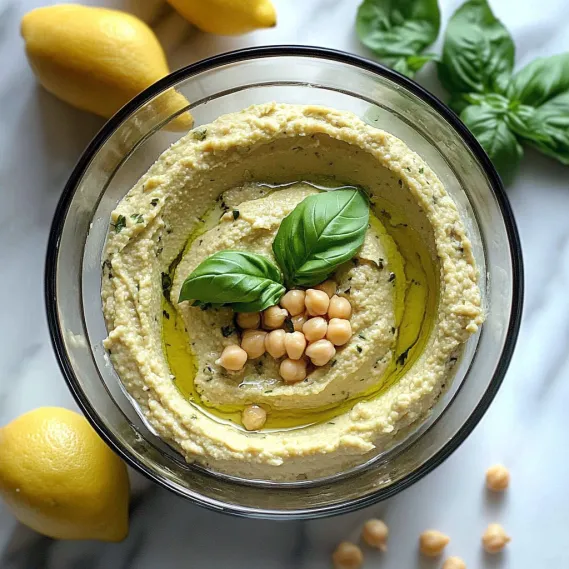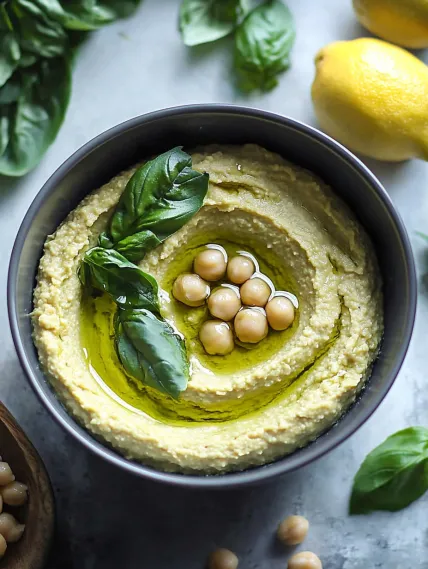 Pin it
Pin it
This lemon basil hummus transforms the classic Mediterranean dip into a bright, herb-infused treat that balances earthy chickpeas with zesty citrus and fragrant basil. Perfect for gatherings or as a nutritious snack any day of the week.
I first made this hummus when hosting an impromptu dinner party and needed something quick yet impressive. The vibrant green color and aromatic basil notes had everyone asking for the recipe before the night was over.
Ingredients
- Chickpeas: Provide the creamy base and pack plenty of protein and fiber
- Fresh basil leaves: Bring a sweet aromatic flavor that elevates ordinary hummus
- Tahini: Adds richness and authentic hummus texture
- Olive oil: Creates silky smoothness and carries flavors
- Lemon juice: Brightens everything with necessary acidity
- Garlic cloves: Give a robust punch, look for firm heads with no sprouting
- Salt: Enhances all other flavors, use kosher or sea salt for best results
- Water: Adjusts consistency without diluting flavor
How To Make Lemon Basil Hummus
- Prepare the chickpeas:
- Thoroughly rinse canned chickpeas under cold water until no more foam appears. This removes excess starch and sodium for a cleaner flavor. Drain completely in a colander, giving it a gentle shake to remove excess water.
- Layer your ingredients:
- Add ingredients to your blender or food processor in the proper order. Place chickpeas and wet ingredients like lemon juice and olive oil closest to the blade. Position basil leaves toward the top. This strategic layering helps create a vortex that pulls everything down evenly during blending.
- Begin the blending process:
- Start with short pulses rather than continuous blending. This gives the blades a chance to grab and pull down ingredients without overheating the motor. The mixture will look chunky at first which is perfectly normal.
- Add liquid gradually:
- With the motor running on low speed, drizzle water through the feed tube or between pulses. Add water a tablespoon at a time until you reach your desired consistency. Stop occasionally to scrape down the sides with a rubber spatula for even processing.
- Final texture adjustment:
- Continue blending until completely smooth, which takes about 3 to 5 minutes for truly silky hummus. The finished texture should be creamy but thick enough to hold its shape when spooned onto a plate.
 Pin it
Pin it
The fresh basil truly transforms this hummus from ordinary to exceptional. I grow basil in my kitchen window box specifically for this recipe. Last summer, I served this at a family reunion alongside regular hummus, and this version disappeared in minutes while the traditional one was barely touched.
Make-Ahead and Storage
This hummus actually improves after resting in the refrigerator for a few hours, allowing flavors to meld. Store in an airtight container for up to 5 days. The natural oils may separate slightly just stir before serving. For longer storage, portion into small containers and freeze for up to 3 months. Thaw overnight in the refrigerator and add a splash of water or olive oil if needed to refresh the texture.
 Pin it
Pin it
Serving Suggestions
This versatile hummus works beautifully as a dip with warm pita, crunchy vegetables, or pita chips. For an elegant appetizer, spread it on a shallow plate, create a well in the center, and fill with extra virgin olive oil and a sprinkle of pine nuts. It also makes a wonderful sandwich spread in place of mayonnaise, particularly with roasted vegetables or grilled chicken. For a light lunch, spread on toast and top with sliced cucumber, radishes, and microgreens.
Customization Options
While this recipe shines as written, you can adapt it to your preferences. For a spicier version, add a pinch of red pepper flakes or a small jalapeño. If you prefer a nuttier flavor, toast the chickpeas in the oven for 10 minutes before blending. Replace up to half the basil with other herbs like parsley or cilantro for different flavor profiles. For a lower fat version, reduce the tahini by half and add an extra tablespoon of water to maintain creaminess.
The combination of lemon and basil makes this hummus particularly refreshing during warm weather. I often pack it for picnics alongside crusty bread and fresh vegetables for an easy outdoor meal that requires no cooking.
Frequently Asked Questions
- → Can I use dried basil instead of fresh?
Fresh basil is recommended for its vibrant flavor, but in a pinch, you could use dried basil. Note that the texture and taste will differ slightly.
- → How do I store leftover hummus?
Store it in an airtight container in the refrigerator for up to 5 days. If it thickens, stir in a small amount of water or olive oil before serving.
- → Can I make this without tahini?
Yes, you can substitute tahini with sunflower seed butter or almond butter for a similar consistency and flavor.
- → Is this hummus freezer-friendly?
Yes, you can store it in a freezer-safe container for up to 3 months. Thaw it in the refrigerator and stir before serving.
- → What can I serve with lemon basil hummus?
Try serving it with fresh veggies, pita bread, crackers, or use it as a spread on sandwiches and wraps.
